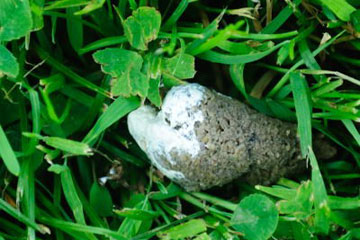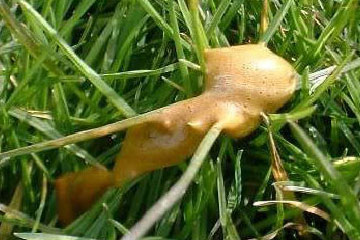The common poultry louse is yellow in colour and flat in shape and lives mostly under the tail. It lays its eggs at the base of the feathers forming a clump of what looks like white sugar. The bird is better off without these, but they are not life threatening.
The de-pluming mite is hard to see as it is very small and is usually found in the head and neck region.
Northern Fowl Mite is a bloodsucker and will eventually kill a bird if left. These mites live on the bird and can be found anywhere, but especially under the tail and in the crest of crested breeds.
The previous three parasites can be controlled by the use of louse powder (or spray). To apply, hold the bird by its legs, turn it on its back and place on the ground or a table, pressing it down gently to hold it still. Sprinkle the powder under the tail, under the wings, along the body, up the neck including the ear canals, and over the back. Rub the powder well in. Once a month should be enough, but all these parasites breed extremely quickly if left unattended. Even if you don’t observe a problem, applying the powder periodically as a preventative measure is advisable.
The red mite lives in the housing (particularly under perches and in cracks or crevices) and feeds on the blood of the bird at night and is again a potential killer if left unattended. Available from most pet stores is a good spray for the housing as it is persistent, but every nook and cranny must be sprayed, including under any felt on the roof and especially in perch sockets. With a ten day life cycle, vigilance against this mite is time well spent.
Raised and encrusted scales on the legs is an indication of the Scaly Leg Mite. It lives and burrows under the scales and causes intense irritation. Surgical spirit in a wide-mouthed jar is an easy treatment and is not toxic to the birds, unlike other preparations. Dunk legs once a week for three weeks, but it will take a long time, maybe a year, for the legs to look normal as scales grow very slowly but are replaced annually. Again, prevention is better than cure and thoroughly cleaning the legs of poultry with soap and warm water to remove any dirt, then rubbing coconut oil (available in solid form from health shops) into the legs (repeating the process every few months) will help prevent scaly leg mite appearing in the first place.
1. CONTROL OF COCCIDIOSIS IN CHICKENS
Cause
A protozoal parasite which multiplies in the gut, specific to different hosts. Not all species of coccidia are harmful but there are seven of the Eimeria species pathogenic to chickens.
Life cycle
Parasitic phase: the infective oocyst (coccidia egg) is eaten by the chicken and then multiplies over about 7 days within the gut of the bird, thousands of new oocysts resulting from just one ingested oocyst.
Non-parasitic phase: excreted in the droppings, the oocysts then take 2 days to mature before being ready for the next host to eat.
Progression
Dayold chicks do not get immunity from their mother. Birds of any age are susceptible, but most acquire infection early in life which gives them some immunity.
Immunity is best kept strong by a low level of infection, which is what happens on free-range. Birds kept or reared on litter are more at risk when the coccidia has conditions which suit it such as wet litter. If the birds are also stressed by environmental factors (cold, overcrowding, poor ventilation) then disease results. The oocysts are very resistant to destruction, either by disinfectants or by drying out.
Symptoms
The seven species of coccidia have different areas of the gut which they prefer, some producing the expected bloody diarrhoea, some producing high levels of mucus, sometimes white diarrhoea, and others stunting growth. Infection can show from 3-6 weeks of age and infective oocysts can be transported by people looking after the birds. Older birds can become infected if either their immunity has been reduced due to being kept on a wire floor (no access to droppings and therefore no trickle infection) and then put onto litter, or if environmental stressors reduce their immunity. The birds generally look hunched and depressed with or without blood in the droppings.
Prevention
Good biosecurity is important. Anticoccidial drugs in the feed for the first 6 weeks of life has been the norm in order to let the chicks have a low level of infection and therefore acquire immunity. With the reduction of permitted drugs in feed, the vaccine using weakened coccidia which has been used by commercial units for 14 years is the way forward. Free-range reduces the incidence of disease while still providing trickle infection to boost immunity. Oocysts can stay in sheds despite disinfection unless a specific oocidal ("egg-killing") disinfectant is used.
Treatment
The only product currently licensed for treatment in chickens is Baycox and this use is restricted to broiler breeders on the data sheet (licence details). Sulphonamides can be ordered from specialist poultry veterinary practices. On a small scale and where the chickens do not enter the food chain, the pigeon product, Coxoid, is used by fanciers. This contains amprolium which used to be licensed for chickens and has proved to be safe.
By far the better treatment and prevention is the vaccine, Paracox. This contains all seven species of coccidia but these are weakened so that they cause the chicken to mount an immune response but not to become infected. As this is an industrial product it normally comes in quantities to treat thousands of birds. It is now available in small quantities to bona fide Poultry Club members via the website (http://www.poultryclub.org) and through order forms. Paracox will be administered once as a solution from a dropper bottle to a healthy dayold chick via its mouth. The shelf-life of the product will be 4 weeks, so orders need to be made with the monthly expected hatch in mind. Any feed used for vaccinated birds should not contain anti-coccidial drugs as this will counteract the vaccine. The vaccine can be used on unvaccinated chicks up to 9 days old but is most effective at day old. Chicks must be kept on litter not wire to allow the vaccine to circulate.
Other species of poultry
Young turkeys and young waterfowl are susceptible to their own species of coccidia. There are no products licensed for treatment in turkeys and waterfowl but Coxoid has been used with success. The coccidia life cycle is similar to chickens and the oocysts persist in the ground.
2. CONTROL OF MAREK'S DISEASE IN CHICKENS
Cause
A herpes virus which both gravitates towards lymphoid tissue (lymphoid tissue is spread throughout a chicken, unlike a mammal where it is confined mostly to lymph nodes) and also causes demyelination of peripheral nerves (leg and wing). Various strains of the virus have been isolated and there are two types, one which lives in the cell and one which is cell-free and lives in the feather follicle. The virus was discovered in 1907 by Jozsef Marek, a Hungarian vet and there are non-pathogenic, mildly virulent, virulent and very virulent strains.
Life cycle
The virus replicates in the host chicken's lymphoid tissue and is shed in feather dander (dust). The virus can remain viable for at least one year in feather dander and henhouse dust.
Progression
Chickens from 6 weeks of age are affected, symptoms are most frequently seen 12-24 weeks of age with the hormonal stress of point of lay being a classic time for the signs to appear. Older birds can sometimes be affected if stressors (changes in weather, food, handling, environment) are not minimised. Females are more susceptible than males.
Symptoms
Mortality is variable and depends on which of the peripheral nerves is affected but leads to progressive spastic paralysis of the legs and wings. Sometimes, if the neck nerves are affected, the neck can twist around. There is an acute form where birds may die suddenly with no symptoms and tumours may be found in the liver, gonads, spleen, kidneys, lungs, proventriculus, heart, muscle and skin.
Infection
The virus is ubiquitous in poultry worldwide. Infection in chicks occurs by inhalation and two weeks later, the virus is shed by the infected chick in feather dander and by oral and nasal secretions. The virus is NOT passed on through the egg. Infected and recovered birds continue to shed the virus for life.
Prevention
Good biosecurity is important, quarantine any new stock for 4 weeks. Rear chicks for 2-3 months away from adult feather dander if adult birds have shown symptoms. Ask vendors if stock has been vaccinated. Genetically resistant breeds include the Fayomi.
Treatment (control)
Cull any affected birds. This increases the resistance to the disease in the surviving birds.
Vaccination is feasible, especially if Silkies or Sebrights are kept. These are very susceptible to clinical signs of Marek's and there would be few of these breeds seen at exhibitions if vaccination was not used. The vaccine is administered twice, once in the water (live vaccine) and once by injection when chicks are slightly older.
In other breeds, using vaccine can hide the virus and so the whole stock gets progressively more susceptible (weaker) without any symptoms and if birds are sold without the recipient being told of the vaccination, the birds can pass on the virus to unvaccinated chicks, thereby bringing the disease to a flock which may have been free of it before.
Diagnosis
Clinical signs of paralysis and post-mortem lesions.
3. MYCOPLASMA IN POULTRY: WHAT IT IS AND WHAT TO DO ABOUT IT
Introduction
Mycoplasma in poultry is not a new disease. There is mention in the old books of similar symptoms from about 100 years ago but it has generally been called roup or a common cold. Treatment tended to be by culling only.
The disease acquired the name mycoplasma once the causative organism had been discovered. Mainly the respiratory system in poultry is affected and the disease may be becoming more common, spreading with increased travelling of stock, or it may be that we are hearing about it more with improved communications. The incubation period before clinical signs appear can be as little as a few days - it is very infectious. It appears to thrive in the bird when other pathogens are present, such as E. coli or infectious bronchitis (IB is certainly now more common in free-range flocks) or if the birds are stressed or debilitated. Debilitating factors include nutritional deficiency, excessive environmental ammonia and dust and stressors such as changes in the pecking order or exhibitions.
Cause and clinical signs
The organism is neither a bacterium nor a virus in size, but part way between, having no cell wall but with a plasma membrane. Four out of the known 17 species of mycoplasma are pathogenic in poultry:
- Mycoplasma gallisepticum: signs can include foamy eyes, sneezing, nasal discharge, swollen eyelids and sinuses, reduced egg production and gasping in chickens, turkeys and pheasants, swollen sinuses in waterfowl. This one is the main culprit in backyard flocks.
- Mycoplasma synoviae: signs include swollen and hot joints in chickens and turkeys and/or respiratory signs as above.
- Mycoplasma meleagridis: signs include poor growth in turkey poults and lowered hatchability in turkey breeders.
- Mycoplasma iowae: signs included reduced hatchability in turkey breeders, twisted legs in turkey poults.
When nasal discharge is evident, feathers become stained with this as the bird tries to clean its eyes and nostrils. There is a particular sweet smell associated with this discharge which to the sensitive nose is immediately apparent when entering a hen house.
Transmission
Nasal discharge and cool temperatures are protective of the organism so any sneezing will deposit droplets which will remain infective for several days. Transmission is also through the egg, plus carried on the clothes and hands of people tending the birds.
Treatment
Antibiotic treatment will not completely cure the disease but will reduce the incidence to a tolerably low level. Tylan Soluble is licensed for the treatment of mycoplasma, as is Baytril. These oral preparations are effective in young stock but seem to be less effective in older stock. Tylan 200 injection (not licensed for poultry) is effective with 0.5ml in the breast muscle of an adult large fowl, repeated 48 hours later if still sneezing. If still noisy after that the bird must be culled as the organism will be too deeply entrenched within the airsacs and hollow bones to be removed, the bird remaining a carrier which will infect others. The reason Tylan 200 is not licensed for poultry is because it harms muscle, which in a meat bird is disastrous but in backyard or fancy poultry which do not enter the food chain, it is not really an issue.
Prevention
- Keep stressors to a minimum or if a known stressor such as a show is imminent, give vitamin supplementation. There are several useful products on the market which contain probiotics and vitamins, administered in the water.
- Use a suitable disinfectant for both huts and equipment such as Virkon or F10.
- Keep dust and ammonia levels low. Ammonia paralyses the small hairs which act like an escalator to move normal mucus up the trachea before being swallowed.
- Feed high quality commercial food for the stage of growth and the species of bird.
- Monitor weather changes and take steps to minimise any effects.
- When attending to the stock, begin with the youngest at the start of the day (i.e. with clean clothes).
- Either quarantine new stock for 2-3 weeks or inject once with Tylan 200 as soon as the birds are obtained if there has been mycoplasma in your flock.
- Some very conscientious breeders inject stock they sell and warn buyers of the disease risk.
- Do not buy from auctions.
- If adult stock are kept symptom-free the risk of passing mycoplasma on through the egg is reduced.
- If young stock happen to be exposed to a mild bout of mycoplasma they will acquire a certain amount of immunity as long as there are no other pathogens present.
Vaccination
There has been a mycoplasma vaccine marketed through Intervet but it is recommended not to use it in breeding birds. This appears to be because the manufacturers do not know how long the vaccine is effective.
With vigilance, mycoplasma can be kept at a low level in backyard flocks thus increasing the welfare of the birds.
Infectious Bronchitis
Infectious Bronchitis is a viral disease initially affecting the respiratory system in a young bird which clears up in a few days. The virus can then localise in the reproductive tract and cause misshapen or soft-shelled eggs with very watery whites when the bird begins to lay. There is no cure once this has happened but there is a vaccine, best given at day old.
For further information speak to your poultry vet.





